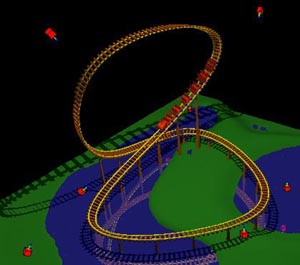1 Using The Camera
Move the mouse while holding the right mouse button to orbit the
camera around the origin. The middle mouse button is used to zoom in
and out on the origin.
You can click on the "Camera mode" button to toggle between
orbit mode and panning mode. In panning mode, you can free-look
around the world with a stationary eye-point. To pan around, use
the right mouse button. You can zoom in and out just like in orbit
mode by using the middle mouse button.
Also, you can click on "Look at coaster" to have the camera
follow the coaster as it moves along the track.
Finally, you can click on "Coaster view" to take a ride on
the roller coaster itself.

2 Creating And Editing A Track
When the program is first run, a pseudo-circular track with four
control points is automatically created. These control points can
be displayed by clicking on the "Show controls" button. To create
additional control points, click somewhere on the screen. You can
also go into "Subdivide mode" by clicking on the appropriate button.
If you now click on a control point, a new control point will be
created halfway between it and the next one.
To move control points, click on them and drag them around the
screen. You can toggle XZ plane movement vs. Y-axis movement by
clicking on the appropriate button. Make sure you're not in a
special mode (such as Scenery mode).
To rotate control point normals, click on "Rotate". Then, click
and drag on any control point to rotate its normal about the tangent
at that part of the curve.
You can also load *.rol files from disk by clicking on
File -> Load. These files contain specifications for a complete
roller coaster track. Clicking File -> Save allows you to save
your track to a file of your choosing.
The track can be calculated from two different types of cubics:
B-Splines and Cardinal splines. To change the kind you want
to use, click on Track and select the type of curve you want to use.
Finally, you can toggle arc-length parameterization. When this
is on, the real-world length of the cubic is used to determine
how far to advance the coaster during each update. This allows for
things like constant velocity and conservation of energy. (This is on by default)
4 Playing With Scenery
There's a variety of scenery objects that you can play
around with in the program. To select the kind of scenery object
you wish to place, click on its name in the scenery list box.
Then, click on "Scenery mode" and start adding scenery. This is
done by clicking somewhere in the main window.
You can exit scenery mode and move the scenery objects around
just as you did for control points. You can also rotate them
about the Y-axis.
If you wish to delete any scenery objects, click on "Delete".
Then, click on any scenery objects that you wish to delete.
5 Terrain
To change the current terrain, click on Terrain -> Creation.
You will be presented with four options. Select one of the
options by clicking on its radio button, fill in any necessary
attribute fields, and click on "Create" to make the terrain.
The four creation types are described below:
- Initialize: creates a small, flat terrain
- Generate random: creates a randomized terrain. You can
control the terrain that it generates by inputting
values into the attribute fields. Width and Depth
control how many height-field cells will be generated
along the two axes of the terrain. Scale is used to
modify how much the terrain is "stretched" horizontally,
and should not be made too large or small (values of
0.1 to 10.0 are okay). Finally, Min height and Max height
control the range of world height values that the
terrain can have.
- Load ASCII: loads a *.ter terrain file. You can type in
a pathname or browse to the file by clicking Browse.
- Load TGA: loads a *.tga terrain file. The red channel
is used to determine the height-field values. Again, you
can type in a pathname or browse for it by clicking Browse.
Terrain can also be modified in a variety of ways. This
functionality is accessed by clicking on Terrain -> Modification.
The four ways to modify terrain are described below:
- Add random layer: adds a random amount to each height-field
cell. The amount is bounded by the specified Min and Max.
- Set new height range: rescales the terrain vertically to
fit within the specified world y-coordinates Min and Max.
- Set new horizontal scale: rescales the terrain horizontally
by the specified scale factor (e.g., 2.0 means that the
terrain will take up twice as much space along the X and Z
dimensions while maintaining its height-field width and depth).
- Fractal subdivide: performs fractal subdivision on the terrain.
You can specify the range of the random values that will be
added to each newly created point. Please note: the resulting
terrain's dimensions will each be doubled (approximately), so
don't do this if your terrain is already at a high resolution.